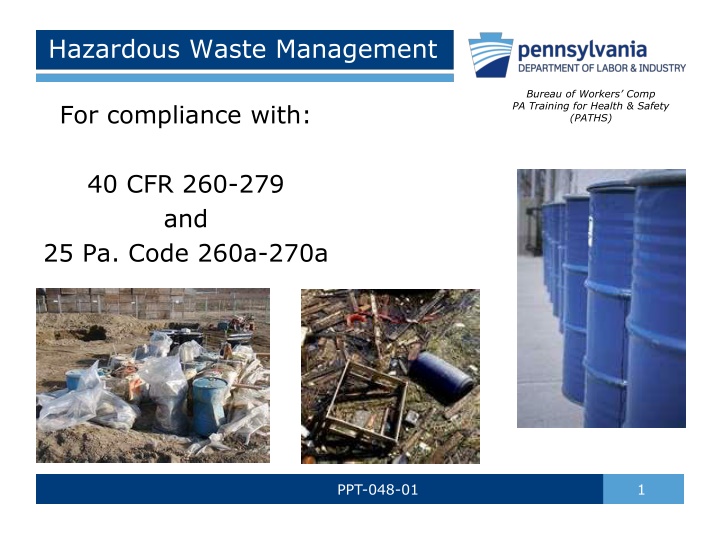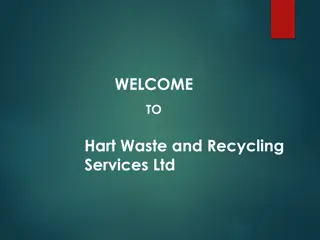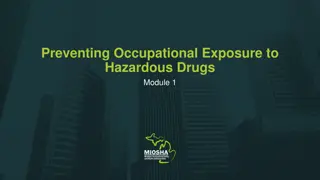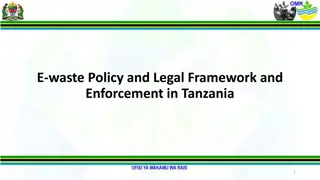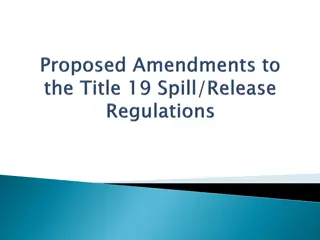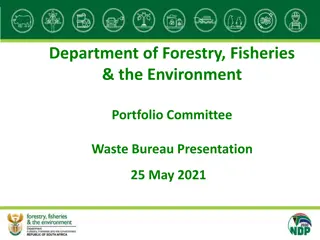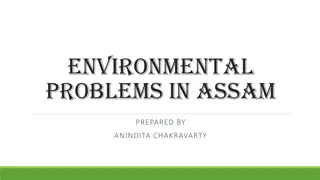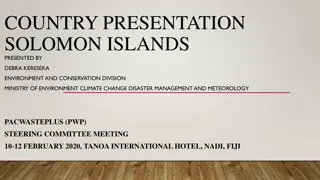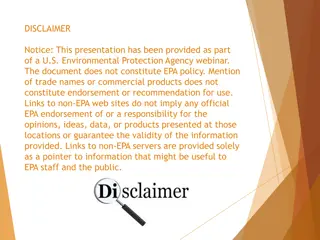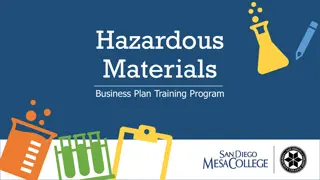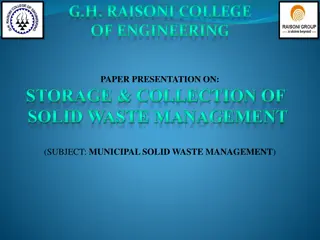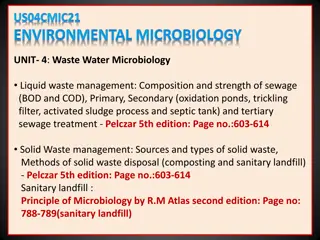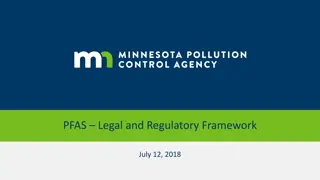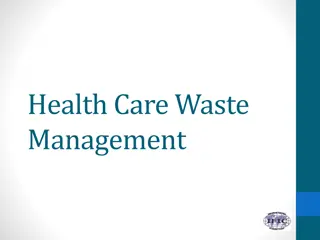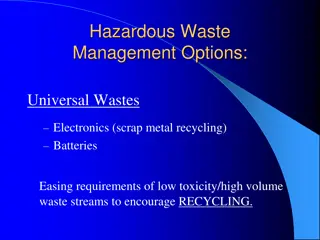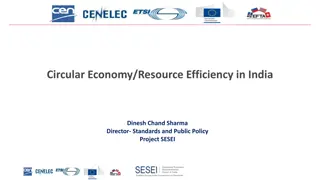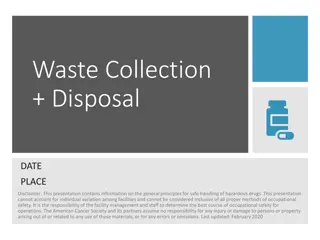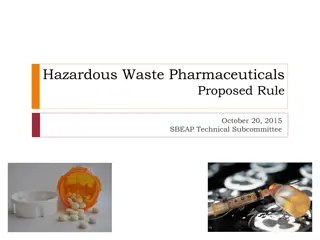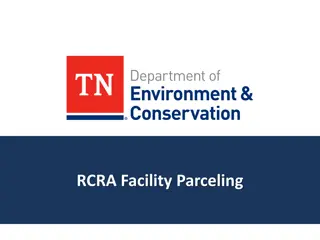Hazardous Waste Management Regulations in Pennsylvania
The hazardous waste management regulations in Pennsylvania outline compliance standards for handling hazardous waste, including storage, identification, transportation, recordkeeping, and emergency response. These regulations incorporate both federal guidelines under RCRA and state-specific requirements to ensure proper management of hazardous waste. When establishing a program, it's crucial to consider the dual use of regulations and adhere to the more stringent requirements.
Download Presentation

Please find below an Image/Link to download the presentation.
The content on the website is provided AS IS for your information and personal use only. It may not be sold, licensed, or shared on other websites without obtaining consent from the author.If you encounter any issues during the download, it is possible that the publisher has removed the file from their server.
You are allowed to download the files provided on this website for personal or commercial use, subject to the condition that they are used lawfully. All files are the property of their respective owners.
The content on the website is provided AS IS for your information and personal use only. It may not be sold, licensed, or shared on other websites without obtaining consent from the author.
E N D
Presentation Transcript
Hazardous Waste Management Bureau of Workers Comp PA Training for Health & Safety (PATHS) For compliance with: 40 CFR 260-279 and 25 Pa. Code 260a-270a PPT-048-01 1
Topics Addressed Regulatory background Storage areas Hazardous waste identification and characterization Pre-transportation requirements Recordkeeping and reporting Hazardous waste generator requirements Emergency response Container storage and tank requirements Waste minimization PPT-048-01 2
Hazardous Waste Management RCRA The Federal Solid Waste Disposal Act, as amended by the Resource Conservation and Recovery Act of 1976 (42 U.S.C.A. 6901- 6986) Federal Environmental Protection Agency, (EPA) Hazardous Waste Management 40 CFR Parts 260 279 and PA Department of Environmental Protection, (PA DEP) 25 Pa. Code Article VII: Hazardous Waste Management, Chapters 260a 270a PPT-048-01 3
Hazardous Waste Regulations Pennsylvania utilizes the following to govern hazardous waste management: Federal Regulations (40 CFR Parts 260 279) 25 Pa. Code Article VII: Hazardous Waste Management Hazardous Waste Regulations PPT-048-01 4
PA Regulations 25 Pa. Code Article VII: Hazardous Waste Management Chapters 260a 270a Incorporates federal regulations by reference ( a after the PA chapter number) PA changed its numbering system in 1990 to be more compatible with federal hazardous waste regulations PA assigned the same numbers in the Pa. Code as exist in the CFR provisions Example: 40 CFR 261.3 = 25 Pa. Code 261a.3 PPT-048-01 5
Consider Due to the dual use of these regulations, when establishing your program, be mindful of two conditions in the regulations: Where 40 CFR and 25 Pa. Code are cited, often the more stringent requirement will apply, and Federal regulations incorporated by reference are substituted with Pennsylvania procedures This will help you recognize the governing regulations and sections with which you should comply. PPT-048-01 6
(RCRA)- Federal Regulations Federal Regulations (40 CFR Parts 260 279) and 25 Pa. Code Title VII Cradle To Grave Management (Generation, Transportation, Disposal) RCRA The Federal Solid Waste Disposal Act, as amended by the Resource Conservation and Recovery Act of 1976 (42 U.S.C.A. 6901 et seq.) Regulates hazardous waste from generation to disposal PPT-048-01 7
Why We Need to Comply With the RCRA Violation of the regulation: civil or criminal penalty Civil penalties and administrative actions Depends on the potential for harm (major, moderate, minor) Depends on the deviation from compliance (major, moderate, minor) Fines range from $100s to $1,000s PER DAY Each day is a separate occurrence Criminal penalties Knowing or willful violations PPT-048-01 8
Generator Anyone who creates waste: Has responsibility to determine if waste is hazardous or nonhazardous Must take proper steps to handle waste Generators are categorized as: CESQG-Conditionally exempt small quantity generator SQG-Small quantity generator LQG-Large quantity generator PPT-048-01 9
Transporter The licensed party in charge of offsite removal of solid waste at any time after generation PPT-048-01 10
Treatment Method, technique or process, including neutralization Designed to change physical, chemical or biological character or composition of waste Render it nonhazardous, safer for transport, suitable for recovery (storage, or reduced in volume) Includes activity or processing designed to change the physical or chemical composition (render it neutral or nonhazardous) PPT-048-01 11
Storage Containment of a waste Temporary basis Presumption: containment of a waste in excess of one year constitutes disposal PPT-048-01 12
Disposal Defined Incineration, deposition, injection, dumping, spilling, leaking or placing of solid waste into or on the land or water that the solid waste or a constituent enters the environment, is emitted into the air or is discharged to the waters of the commonwealth. PPT-048-01 13
What is Solid Waste? Does not depend on the physical state of the material (solid, liquid, gas) Solid Waste: Any garbage Refuse Sludge from a waste water treatment plant, water supply treatment plant or air pollution control facility Other discarded material including solid, liquid, semi-solid or contained gaseous material Results from industrial, commercial, mining and agricultural operations and from community activities PPT-048-01 14
Solid Waste Solid waste: any discarded material Discarded: abandoned, considered inherently waste-like, military munitions, recycled (with exceptions) PPT-048-01 15
Some Solid Waste Exemptions Domestic sewage Industrial wastewater point source discharges Irrigation return flows Byproducts defined by Atomic Energy Act Some mining materials PPT-048-01 16
Some Solid Waste Exemptions Reclaimed/reused pulping liquors. Spent sulfuric acid used to make new sulfuric acid. Materials that are reclaimed/returned into original process. Spent wood preserving solutions that are reclaimed/reused for treating wood. PPT-048-01 17
What is Hazardous Waste? Determine: is the waste a solid waste? All hazardous wastes are solid wastes Solid Waste Hazardous waste Not all solid wastes are hazardous waste PPT-048-01 18
Hazardous Waste RCRA: A solid waste, or combination of solid wastes, which because of its: quantity, concentration, physical, chemical, infectious characteristics may pose a hazard to human health or the environment. PPT-048-01 19
Hazardous Waste Identification Known to be fatal to humans in low doses. Exceeds toxicity data in rats with serious irreversible effects. Universal waste. PPT-048-01 20
Universal Waste Mercury-containing devices (e.g., thermostats, switches, barometers) Lamps (e.g., neon, fluorescent, etc.) Agricultural chemicals (pesticides/herbicides) Batteries (e.g., Lead-acid, NiMH, Li-ion, NiCd) PPT-048-01 21
Determine if Waste is Hazardous First: Is waste excluded from 40 CFR 262.11? Listed? Check 40 CFR 261, Subpart D Characteristic? 40 CFR 261, Subpart C to determine ignitability, corrosivity, reactivity, toxicity. PPT-048-01 22
Determine if Waste is Hazardous Explicitly named on one of the lists in the regulations (bearing F, P, K, U Codes). Exhibits hazardous characteristics on standardized test procedures specified in the regulations (flammable, corrosive, reactive, toxic) (D Codes). PPT-048-01 23
Listed Hazardous Waste F List Hazardous waste from non-specific sources. Example: spent solvents, F001 F005 40 CFR 261.31 PPT-048-01 24
Listed Hazardous Waste K List Hazardous wastes from specific sources, process wastes Example: wastewater treatment sludges 40 CFR 261.32 PPT-048-01 25
Listed Hazardous Waste P List Acutely toxic discarded commercial chemical products or manufacturing chemical intermediates. Example: Unused hydrofluoric acid to be discarded; phosgene. 40 CFR 261.33 PPT-048-01 26
Listed Hazardous Waste U List Systemically toxic; discarded commercial chemical products or manufacturing intermediates, such as acetone. 40 CFR 261.33: Primary hazards are ignitability, reactivity, corrosivity or toxicity. PPT-048-01 27
Characteristics Hazardous Waste (D codes) Wastes that have not been listed by the EPA. Still have to be reviewed to determine if they exhibit certain characteristics. EPA chose four characteristics that could be measured by an available standardized test method. 40 CFR 261, Subpart C. PPT-048-01 28
Four Traits of Hazardous Waste Ignitability (D001) Corrosivity (D002) Reactivity (D003) Toxicity (D004 D043) PPT-048-01 29
Ignitability (D001) Liquid with a flash point less than 140 F Not a liquid, but is capable of causing vigorous, persistent and hazardous fire through friction, spontaneous chemical changes PPT-048-01 30
Ignitability (D001) Ignitable compressed gas Oxidizer PPT-048-01 31
Corrosivity (D002) Aqueous pH range: <2 (acidic) or > 12.5 (basic) (pH 1 6=acid; pH 7=neutral; pH 8 14=base) Liquid that corrodes steel greater than 6.35 mm (0.250 inches) per year at 130 F. PPT-048-01 32
Reactivity (D003) Normally unstable; readily undergoes violent changes without detonating. Reacts violently with water, forming potentially explosive mixtures or generating toxic gases, vapors or fumes sufficient to present a danger to human health or the environment. PPT-048-01 33
Reactivity (D003) Cyanide or sulfide containing waste that, when exposed to pH conditions between 2 12.5, can generate toxic gases, vapors or fumes in quantities sufficient to present a danger to human health or the environment. PPT-048-01 34
Reactivity (D003) Capable of detonation or explosive reaction at standard temperature- pressure (STP) if subjected to strong initiating source or heated under confinement. PPT-048-01 35
Reactivity (D003) Forbidden explosive, Division 1.1, 1.2 or 1.3 (per 49 CFR 173.50 and 173.53) PPT-048-01 36
Toxicity (D004-D043) Wastes likely to leach dangerous concentrations of toxic chemicals into the groundwater. 40 CFR 261.24 Table 1 Toxic Characteristic Leaching Procedure (TCLP) Method 1311. PPT-048-01 37
Characterizing Hazardous Waste To determine if a waste is hazardous, subject a sample to: Analytical testing MSDS Generator knowledge Field testing PPT-048-01 38
Mixture Rule Mixtures of nonhazardous waste and listed hazardous waste: treat as hazardous waste, (unless hazardous portion is a characteristic hazardous waste and no longer exhibits a hazardous characteristic). Note: Mixture exceptions do not apply when the wastes are intentionally mixed to achieve dilution (would be considered treatment and require a special permit). PPT-048-01 39
Hazardous Waste Generator Requirements Once facility determines it generates hazardous waste, it must: determine generator status. understand requirements associated with that status. PPT-048-01 40
Hazardous Waste Generator Categories Conditionally Exempt Small Quantity Generator (CESQG): Generates up to 100 kg (220 lbs) of hazardous waste per month or up to 1 kg of acutely hazardous waste per month. PPT-048-01 41
SQG Small Quantity Generator (SQG): Generates more than 100 kg (220 lbs) but less than 1,000 kg (2,200 lbs) of hazardous waste per month & not more than 1 kg of acutely hazardous waste per month. PPT-048-01 42
LQG Large Quantity Generator (LQG): Generates over 1,000 kg (2,200 lbs) of hazardous waste per month; or more than 1 kg of acutely hazardous waste a month. PPT-048-01 43
General HW Generator Requirements Identify/characterize hazardous waste streams. Obtain EPA identification number (EPA Form 8700- 12). Accumulate waste on site according to specified standards. Properly prepare hazardous waste shipments. PPT-048-01 44
General HW Generator Requirements Determine land disposal restrictions (LDR). Recordkeeping of manifests, training, regulatory reports, etc. Source reduction strategies. Training. PPT-048-01 45
General HW Generator Requirements Use uniform hazardous waste manifest for shipment of wastes. Use only transporters and treatment, storage and disposal facilities (TSDF) that: have an EPA ID number and are licensed and permitted to accept specific waste. PPT-048-01 46
CESQG Requirements Determine if waste is hazardous. Generate in a calendar month no more than: 100 kg of any hazardous waste 1kg of acute hazardous waste No accumulation time restrictions. Post required emergency contact information next to telephone. PPT-048-01 47
CESQG Requirements Comply with container rules. Dispose of at an approved site. PPT-048-01 48
SQG Requirements Determine if waste is hazardous. Obtain an EPA identification number. Accumulate more than 100 but less than 1,000 kgs (2,200 lbs) of hazardous waste a month. And up to a total of 1 kg of acutely hazardous waste a month. Store HW for up to 180 days (except in satellite accumulation areas). PPT-048-01 49
SQG Requirements Provide notice to EPA required (Form 8700-12). Appoint an Emergency Response Coordinator. Are subject to manifest rules. Must comply with container rules. PPT-048-01 50
